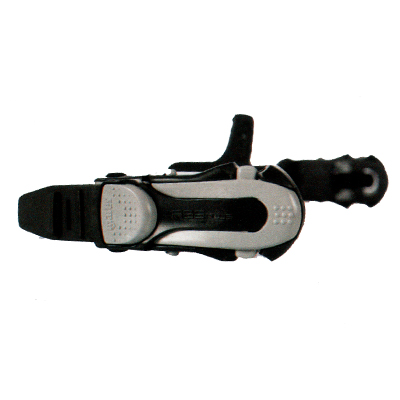Introduction
In my opinion, if there is a single piece of equipment that makes kitting up easier then spring straps have to be either at the top of, or near the top of the list. A brilliantly helpful buddy is also there too. Some people just seem to have a better capacity and are able to sort themselves out AND assist others at the same time.I am going to discuss two slightly different spring straps as part of this review. My point with this review is to review spring straps as an object as opposed to a brand specific review, but you will also be getting that as a spin off (but like I said its not the primary focus to compare and contrast).
Spring What?
Spring straps, they are simply straps (for your fins) that are made of springs. And that is it - they are simple and fuss free. To explain better, I think its better to show the "competition":Rubber Fin Straps
The fundamental part of the traditional fin strap is the rubber fin strap itself. A typical one is shown below: |
| Traditional rubber fin strap |
Plastic is also made from hydrocarbon polymers however, these tend to be shorter and more of a network. This means that while the individual bonds are still able to stretch in the same way as rubber, the overall magnitude of the stretch is less. This on its own isn't a massive issue : a slightly less stretchy material isn't too problematic.
The issue is that plastics become brittle with decreasing temperature. Whilst you are hardly diving in liquid helium at nearly Absolute Zero, British and Northern divers WILL be diving in water easily approaching 2-3oC. At these temperatures, hydrocarbon polymers because less elastic. In the short term this simply means less stretchy. The other issue is that it reduces the force required to cause plastic (i.e. permanent) deformation. So what does THIS mean? It means that with time the plastic strap will become significantly more fatigued and more likely to fail, i.e. snap. And when will it do it? At the point it is under the most loading i.e. when you are trying to stretch it over your feet just as you are about to jump in.
Buckles
Plastic buckles suffer from the same materialistic issues as the straps explained above, but I don't think that this actually their biggest problem. The buckles have been designed with the assumption that all divers are in the Maldives.What I mean by this is that they are very fiddly, using them whilst wearing gloves is hard work, and when your hands are cold and wet I find that the buckles are actually painful to use.
I see many divers struggling with the strap and buckle system, most struggle in different ways, but its still a struggle to get that little fiddly bit of plastic slotted in the socket and pull the strap tight.
 |
| Plastic buckles |
And the alternatives?
Having looked at traditional "rubber" straps and their buckles, I personally am of the view that they are not a great choice, so what's our alternative? Well permanently riding a scooter is an option, certainly one I'd love, but the Bank of Santander says no.| Simple spring strap (from www.oms-russia.ru) |
 |
| Buckled spring straps (from bluewatersports.com) |
The XS Scuba ones that I recommend (for Jet Fins and Jet Fin variants like Turtle fins, Hollis F1 etc) attach by going through the mounting point of the old rubber fins. So these are not going anywhere once attached. Although I do also have the "generic fin straps" that I've provided a link for below on one pair of fins (my "summer non-drysuit fins")
Whilst research the XS Scuba straps, I also found that they now come with both types of connection (the pins and the studs).
Sources
- Generic Fin Straps - Underwater World - £15.73
- XS Scuba Spring Straps - DIR Direct - £47
